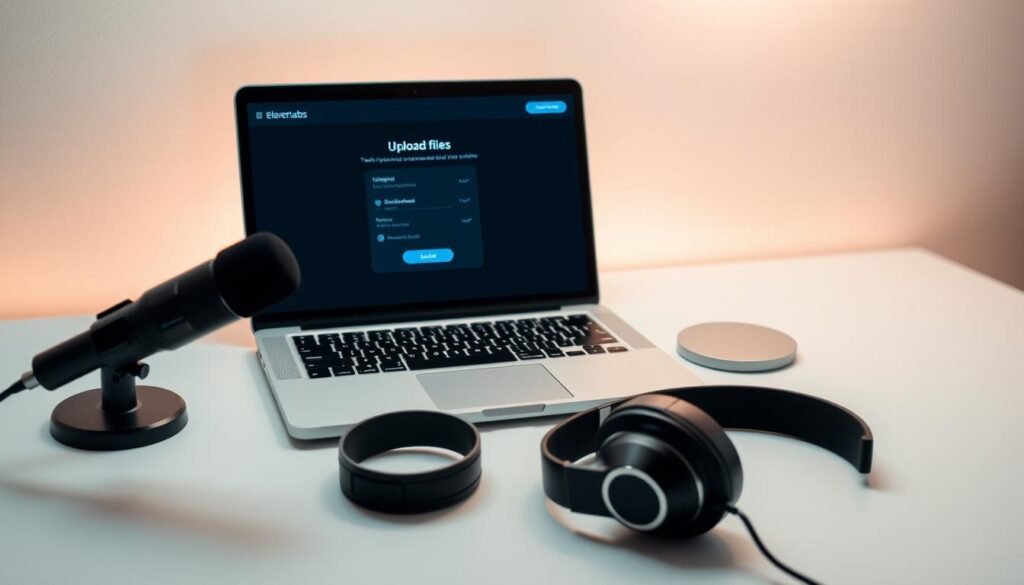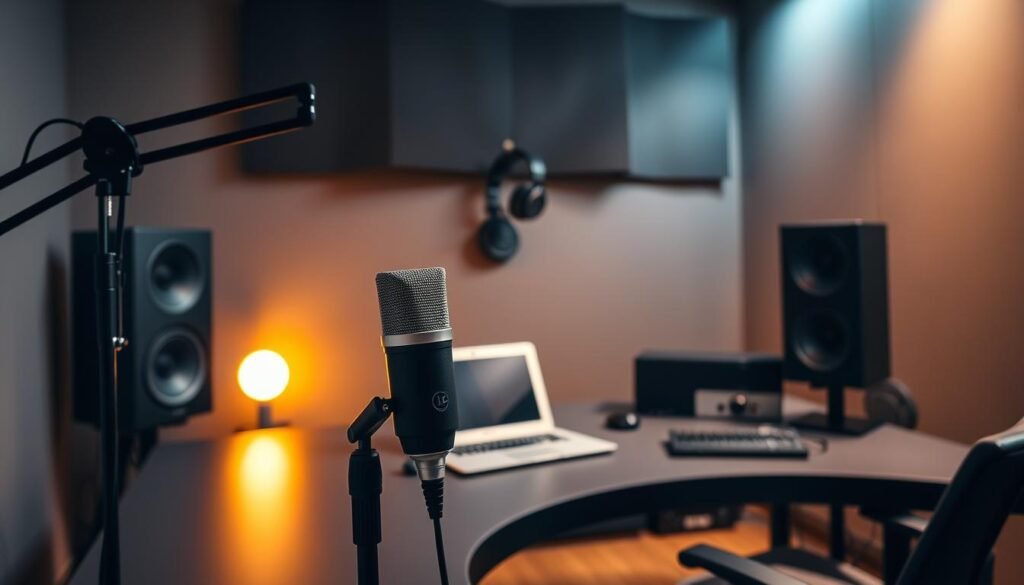Creating realistic AI voices is key in many fields, like entertainment and customer service. Thanks to tech progress, making voices sounds real is easier and more precise. ElevenLabs is a top choice for voice cloning and text-to-speech tech.
Getting ElevenLabs voice cloning set up might seem hard, but it’s actually simple with the right help. This article will guide you through 9 easy steps. You’ll learn how to use ElevenLabs voice cloning to create realistic AI voices for your projects.
Key Takeaways
- Understand the basics of ElevenLabs voice cloning
- Learn how to set up realistic AI voices
- Discover the 9 proven steps to master ElevenLabs voice cloning
- Get insights into optimizing your voice cloning experience
- Explore the possibilities of text-to-speech conversion
- Improve your content creation with AI-generated voices
What is ElevenLabs Voice Cloning?
ElevenLabs uses advanced tts api and speech synthesis to create unique voice clones. This technology lets users make realistic AI voices. It’s changing the game in entertainment, education, and publishing.
The tech behind ElevenLabs voice cloning is complex. It uses algorithms to learn and mimic a person’s voice. This is done through voice model training, where AI is trained on audio samples to create a digital voice clone.
Overview of Voice Cloning Technology
Voice cloning has come a long way, with ElevenLabs leading the charge. The process starts with recording high-quality audio samples. These samples are then used to train a voice model.
This model can then generate speech that sounds just like the original voice. The tech has many uses, from creating personalized voice assistants to making voiceovers for videos and audiobooks.
Applications of Voice Cloning
ElevenLabs‘ voice cloning has many uses across different fields. For example, publishing companies like The Washington Post and The Atlantic use it for engaging audio content. Other uses include:
- Podcast voiceovers
- Audiobook narration
- Personalized voice assistants
- Video game characters
Benefits of Using ElevenLabs
Using ElevenLabs for voice cloning offers many benefits. Some key advantages are:
| Benefit | Description |
|---|---|
| High-Quality Voice Synthesis | ElevenLabs‘ tech makes cloned voices sound natural and realistic. |
| Easy Integration | The platform offers APIs and tools for easy integration into various applications. |
| Customization Options | Users can adjust pitch and tone to fine-tune the cloned voice as needed. |
By using ElevenLabs‘ voice cloning, businesses and individuals can create top-notch, customized voice solutions. These solutions can enhance projects and engage audiences.
Getting Started with ElevenLabs
Starting your ElevenLabs journey is easy. First, create an account, pick a subscription plan, and learn the dashboard. This will help you use the platform, like a podcast voiceover tool.
Creating an Account
Begin by signing up on the ElevenLabs website. Click the “Sign Up” button at the top right. You’ll need to enter your name, email, and password. After verifying your email, your account will be ready.
Choosing Your Subscription Plan
ElevenLabs has plans for everyone, from casual users to pros. Prices start at $5 a month and go up to $330 for top features. There’s also a free trial to try out audio cloning tips and more before you buy.
Accessing the Dashboard
After setting up your account and plan, you’ll get to the dashboard. It’s where you manage your projects, like uploading files and adjusting voices. Spend time exploring to use the platform fully.
By following these steps, you’re ready to use ElevenLabs for voice cloning. Whether for audio cloning tips or as a podcast voiceover tool, ElevenLabs is easy to start with.
Preparing Your Audio Samples
To get a top-notch voice clone, you need to prepare your audio samples well. The quality of your voice clone depends on the quality of your audio samples. This means picking the right voice, recording it well, and editing it to fit ElevenLabs‘ standards.
Selecting the Right Voice
Picking the right voice is key. It should be clear, consistent, and fit your needs. Think about the tone, pitch, and emotions you want to share.
Recording High-Quality Audio
For great audio, use a good mic and software. Make sure the recording area is quiet. Speak clearly and at a steady pace to help the AI model.
Editing Your Audio Files
Editing your audio is vital. Cut out the extra parts, make the volume even, and check the format. ElevenLabs has specific rules for file format and quality.
| Audio Quality Factor | Recommended Setting | Impact on Voice Clone |
|---|---|---|
| Sample Rate | 44.1 kHz or higher | Affects the clarity and detail of the voice clone |
| Bit Depth | 16-bit or higher | Influences the dynamic range and overall quality |
| File Format | WAV or MP3 | Determines compatibility with ElevenLabs’ system |
By carefully preparing your audio samples, you can get a high-quality voice clone. It’s all about the preparation, whether for synthetic narration or other uses.
Uploading Your Audio to ElevenLabs
After getting your audio ready, it’s time to upload it to ElevenLabs. This step is key for making a top-notch voice clone.
File Format Requirements
ElevenLabs needs specific audio file formats for the best results. They support WAV, MP3, and AIFF. Make sure your files are in one of these formats before you upload.
- Sample rate: 44.1 kHz or higher
- Bit depth: 16-bit or 24-bit
- Channels: Mono or stereo
Steps to Upload Audio
Here’s how to upload your audio to ElevenLabs:
- Log in to your ElevenLabs account and go to the dashboard.
- Click the “Upload Audio” button.
- Pick the audio file you want to upload, making sure it fits the format requirements.
- Wait for the upload to finish and check that it went through without a hitch.

Troubleshooting Upload Issues
Having trouble uploading? Here are some troubleshooting tips:
- Double-check that your file is in the right format.
- Make sure your file isn’t damaged.
- Check that your internet connection is strong.
If you’re facing tough issues, look at ElevenLabs’ support resources or reach out to their customer service. They can help with tts api and other tech problems.
Customizing Your Voice Model
To make a voice clone that’s truly yours, ElevenLabs lets you fine-tune it with care. Customizing your voice model is key to getting realistic AI voices that grab your audience’s attention.
Adjusting Pitch and Tone
Adjusting pitch and tone is a big part of customizing your voice model. ElevenLabs offers many options to tweak these settings. This makes your synthetic narration sound as natural as can be.
Changing the pitch lets you make your voice clone sound younger or older. It’s all about what you need for your project.
The tone adds emotion and depth to your voice clone. You can choose from formal to friendly tones. ElevenLabs’ tools help you get the tone just right.
Setting Up Voice Characteristics
ElevenLabs also lets you set up other voice characteristics. You can adjust pace, emphasis, and emotional nuances. This way, you can make a voice clone that sounds real and connects with your audience.
Fine-Tuning Parameters for Best Results
The last step is fine-tuning your voice model for the best results. ElevenLabs’ easy-to-use interface lets you try different settings. You can listen to how it sounds in real-time.
This back-and-forth process helps ensure your voice clone is just what you want. It’s perfect for commercials, narrations, or any other project.
With ElevenLabs’ advanced tech and customization options, you can create realistic AI voices. These voices will take your projects to new heights and engage your audience like never before.
Testing Your Voice Cloning Setup
Testing your voice cloning setup is key to seeing how well it works. This step is important to make sure your cloned voice sounds right and works in different situations.
Running Initial Tests
To test your voice cloning, start by making a few audio clips. Use different texts and contexts to see how your cloned voice does. Listen closely to how natural the voice sounds and if it captures your original voice’s nuances. Try the voice in various settings, like reading news or telling stories.
Here are some audio cloning tips to keep in mind:
- Test your voice clone with different scripts.
- Check if the voice is clear and easy to understand.
- Compare the cloned voice to your real voice to spot any differences.

Evaluating Voice Quality
Checking the quality of your cloned voice is vital. You should see how much it sounds like your real voice and if it’s up to your standards. Listen for any odd sounds or distortions. Getting feedback from others can also help.
Focus on these key points:
- How clear and smooth the speech is.
- The emotional feel and tone of the voice.
- How natural and human-like the voice sounds.
Making Adjustments as Needed
If your tests and quality check show room for improvement, it’s time to tweak your setup. You might need to adjust the voice model training settings, change the pitch, or re-record some audio. This could make a big difference.
“The key to a successful voice cloning project lies in the details. Continuous testing and refinement are key to a top-notch voice clone that meets your needs.”
By being thorough in your testing and evaluation, you can make sure your voice cloning setup works its best.
Integrating ElevenLabs with Your Project
ElevenLabs offers a powerful way to add high-quality voice cloning to many projects. This opens up lots of possibilities for developers, content creators, and businesses. They can use advanced voice technologies in new and exciting ways.
Application Scenarios
ElevenLabs works well in many areas, like podcast voiceover tools and audiobooks. It’s great for making voices that feel personal, like custom voice assistants or narrations for videos.
Its flexibility is perfect for various industries, from entertainment and education to marketing and customer service. For example, a podcast creator can use ElevenLabs to keep their voice consistent. This makes listeners more engaged.
Using API for Integration
ElevenLabs has a detailed TTS API for developers. It helps them add voice cloning to their apps. The API comes with clear instructions and code examples to make integration easy.
With the ElevenLabs API, developers can make voices that fit their needs. They can tweak things like pitch, tone, and speed to get the perfect voice.
Case Studies of Successful Implementation
Many projects have used ElevenLabs voice cloning and seen great results. For instance, an audiobook publisher used it to make their narrations more engaging. This led to happier listeners.
Another example is a company that built a voice assistant with ElevenLabs. The TTS capabilities made the user experience very realistic and engaging. This shows how ElevenLabs can be used in real-world applications.
Maintaining Your Voice Cloning Model
To keep your voice cloning model working well, you need to do regular maintenance. This means updating it often, listening to feedback, and adjusting to new needs. This way, your model will always perform at its best.
Regular Updates and Improvements
Regular updates are key to keep your voice cloning model top-notch. You should update it with new data, tweak settings, and use the latest voice model training tech.
- Check and update your training data to match changes in voice styles or new needs.
- Adjust model settings to improve how it sounds and works.
- Keep up with voice cloning tech advancements to add new features.
Experts say, “Keeping up with learning and adapting is vital for voice cloning success.”
“Voice cloning is always changing, and to stay ahead, you must keep investing in training and updates.”
Collecting Feedback
Getting feedback from users and others is very important. It helps you see how your model is doing in real use. This feedback can show you what to improve next.
| Feedback Source | Actionable Insights | Improvement Opportunities |
|---|---|---|
| User Reviews | Find out what people like and dislike | Make the model better to meet user needs |
| Performance Metrics | Look at how well the model is doing | Make the model better with new settings |
| Stakeholder Input | Learn about business or operational effects | Make the model better to meet stakeholder needs |
Adapting to New Requirements
Being able to change your voice cloning model for new needs is critical. This might mean adjusting it for new voices, languages, or user wants.
Being flexible and adaptable is important for a good voice cloning model. By being open to new needs and changing user wants, your model stays useful and effective.
By following these tips and being proactive in model care, you can get the most out of your voice cloning model. This will help you achieve top-notch synthetic narration.
Maximizing the Power of ElevenLabs Voice Cloning
To get the most out of ElevenLabs voice cloning, it’s key to check out the platform’s extra features. This way, users can discover new ways to make realistic ai voices for their projects.
Advanced Features and Community Engagement
ElevenLabs keeps getting better, with new stuff added all the time. Users can keep up by talking with the community, sharing their stories, and learning from others. This teamwork can offer great tips and help users get the most from their voice cloning.
Staying Informed About Future Trends
As voice cloning tech grows, it’s important to keep up with the latest news. By following industry trends and ElevenLabs updates, users can use the best methods for making realistic ai voices.
By looking into extra features, joining the community, and keeping up with trends, users can really make the most of ElevenLabs voice cloning. They’ll get amazing results in their projects.


